Rice paper rolls are a popular food from Vietnamese cuisine that have been named Nama Harumaki in Japanese and adapted to suit Japanese palates. The tasty rolls are often filled with fresh vegetables, herbs, and some kind of protein, and served with a tasty dipping sauce. They’re the perfect light and refreshing meal, a fantastic alternative to sandwiches, and a delicious way to eat your daily dose of veggies.
Table of contents
What is Rice Paper Rolls : Nama Harumaki
Nama Harumaki is the Japanese name for Vietnamese spring rolls or rice paper rolls and comes from the words “Nama” meaning fresh or raw and “Harumaki” which translates to “spring roll”. This delectable dish is made by wrapping vegetables, some kind of protein, and other ingredients like herbs or vermicelli noodles in very thin rice paper wrappers. The fillings can vary depending on preference, but some common ingredients include shrimp, pork, tofu, chicken, avocado, cucumber and carrot strips. There are many filling options and combinations so every roll is packed full of flavours with a variety of textures. These fresh spring rolls make a delicious and healthy meal that everyone will love.
Ingredients you need
rice paper wrappers
Rice paper wrappers are a versatile ingredient that bring a unique texture to any dish. Made from rice flour, these thin and translucent sheets are perfect for wrapping up all sorts of ingredients – from veggies to meat to seafood. They feel delicate and crisp when dry but soaking them very briefly in warm water makes them pliable and stretchy. It makes it easy to wrap the ingredients inside into a little parcel and provides a satisfying chewiness. The sheets have a neutral taste which allows the ingredients inside to shine through.
Veggies
Add some crunch and other texture to the fresh rice paper salad rolls with your favourite vegetables. Here are some options:
Carrots: These bright orange roots are packed with nutrients like Vitamin A and fiber. They also add a vibrant colour and a satisfying crunchiness to the rice paper rolls.
Cucumber: Another great crunchy addition is cucumber. Its refreshing taste and high water content makes it the perfect filling for hot summer days. Plus, cucumbers are low in calories so you can munch away guilt-free.
Leafy greens: From crispy iceberg lettuce to nutrient-packed kale, there’s no shortage of options. They are full of vitamins and minerals to use for rice paper roll wraps.
Bean sprouts: these are packed with vitamins and minerals, making them an excellent addition. They also have a satisfying crunch and bring a burst of flavour to nama harumaki.
Cabbage: both green and purple cabbage are a great rice paper roll ingredient for added texture and flavour.
Pepper: green and red bell pepper add colour, freshness, subtle sweetness, and crunch to the rolls and taste delicious.
Edamame: add a touch of nuttiness with edamame beans to nama harumaki.
Avocados: rich in heart-healthy fats and loaded with fiber, avocados add a delicious creaminess to the rice paper rolls.
Proteins
Meat: common and popular ingredients include chicken (plain or seasoned with teriyaki); pork and pork belly; beef slices; mince/ground meat;
Seafood: fresh seafood is a great protein for rice paper rolls. Popular options include shrimp (prawns) and crab sticks (kanikama/surimi).
Other: use plain or seasoned tofu to make rice paper rolls vegan friendly (or just use vegetables only).
Other ingredients
Vermicelli noodles: these thin rice noodles are a popular ingredient to add to rice paper rolls.
Herbs: Looking to add a little zest to your Nama Harumaki? Adding herbs such as shiso and mint elevate the rolls with their unique flavor profile.
Shiso, also known as perilla, is a leafy herb commonly used in Japanese cuisine. It has a slightly sweet and spicy taste, similar to basil. The leaves are often used fresh and can be found in both green and purple varieties. Shiso pairs well with seafood, pork, and tofu in the spring rolls.
Mint is another herb that adds a refreshing kick to Nama Harumaki. Its cool flavor helps balance out spicier ingredients like jalapenos or Sriracha sauce. Mint is also rich in antioxidants and can aid digestion.
Step-by-step guide on how to make Japanese Nama Harumaki
Preparing the fillings
First prepare the filling ingredients. Make sure that all your vegetables are washed and thoroughly dried before slicing them into thin matchsticks. Vegetables like lettuce leaves or avocado slices don’t need to be sliced like this. If using cooked shrimp, crab meat, pork, chicken and beef, cut them into small pieces.
Wrapping and Rolling the ingredients in rice paper
- Soften the Rice Paper Wrappers – To wrap your ingredients in rice paper, you’ll need to soften them first. To do this, fill a large shallow bowl or frying pan with warm water. Dip one rice paper wrapper at a time into the water for about 10 seconds until it becomes soft and pliable. Be careful not to over-soak the wrapper as it may become too sticky and difficult to work with.
- Arrange Your Fillings on the Wrapper – Place lettuce leaves on top of the rice paper wrapper, leaving about an inch of space at the bottom edge. Then add your sliced vegetables and protein on top of the lettuce leaves.
- Wrap It Up – Fold up the bottom edge of the wrapper over your fillings. Next, fold in both sides towards each other tightly over the filling. Finally, roll up tightly from bottom to top until completely sealed.
- Repeat these steps with all remaining ingredients until you have made as many Nama Harumaki rolls as desired!
Dipping Sauce
Rice paper rolls are especially delicious when served along with dipping sauce. Dipping sauces take the rice paper rolls to the next level and add even more flavour.
The best part about rice paper roll dipping sauce is that it comes in all sorts of flavours. From sweet to tangy, spicy to savoury – there’s a sauce for everyone! The classic peanut sauce is always a crowd favourite. It’s usually made with tamari and peanut butter which creates a nutty taste blended with a creamy texture. You can also add chili paste for a spicy kick.
If you’re looking for something light and refreshing, try making a citrus-based sauce using yuzu juice or lime juice as its base. Add some fish sauce, sugar, garlic and chili flakes to balance out the sourness of the citrus fruits.
For those who love heat, sriracha is the way to go! This spicy dipping sauce will give your rice paper rolls an extra fiery kick. Or if you want something with a bit of spice and sweetness, use sweet chilli. This is a popular sauce option and my personal favourite.
If you’re feeling adventurous and want to try something new, why not make your own unique dipping sauce? Start by mixing together different ingredients such as soy sauce, hoisin sauce or tamarind paste with honey or rice vinegar until you find a flavour combination you love.
Rice paper rolls are already delicious on their own but pairing them with different dipping sauces takes them up another notch. So get creative in the kitchen and experiment with various flavours.
Tips for Making Japanese Rice Paper Rolls
- Soak the Rice Paper Properly. It’s important to soak the rice paper properly so it is the right texture. Take one sheet at a time and soak it in warm water for about 10 seconds until it becomes soft and pliable but not too sticky.
- Choose Fresh Ingredients. Choose fresh ingredients such as lettuce, cucumber, carrot, peppers, mint leaves, and other herbs to make sure the rice paper rolls have the freshest flavour and the right crunch. Make sure all the ingredients are washed and cut into thin strips before you start rolling.
- Keep Fillings Dry. It’s important to keep the fillings dry so that they don’t make the rice paper soggy and tear apart while rolling. Pat them dry with a kitchen towel before adding them to the roll.
- Start Rolling from One End. Place all your fillings on one end of the rice paper sheet leaving about half an inch uncovered on each side. Fold over both sides inwardly over the fillings then gently roll up tightly till completely sealed.
- Don’t Overfill. Don’t overfill your rolls as this will make them hard to handle. It’s also easier to roll up tightly without breaking apart if there are less ingredients.
FAQ
A : Yes! Rice paper rolls are a great option for those looking for a healthy meal. They are low in calories and fat and packed full of veggies and protein.
A : Yes! You can easily prepare these ahead of time for an easy grab-and-go meal. Just be sure to store them in an airtight container in the fridge until ready to eat.
A : Good news for our gluten-free friends – traditional rice paper rolls are indeed gluten-free! They’re made from rice flour so they do not contain gluten. However be careful that any sauces or other ingredients used don’t contain gluten either.
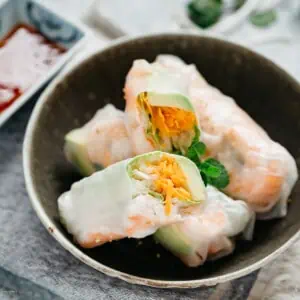
Japanese rice paper rolls
Ingredients
- 4 rice papers
- 12 cooked shrimps
- 2 cups shredded lettuce
- ½ Australian avocado
- 2 cups bean sprouts
- 1 cups shredded carrots
- 12 mint leaves
- 4 Shiso leaves
- ¼ cups Sweet Chilli sauce
Instructions
- Wash bean sprouts, mint leaves and Shiso leaves to set aside
- Cut carrots and shred lettuce.
- Peel cooked prawns and set aside.
- Deseed the avocado and slice them thinly.
- Prepare rice paper per packet instructions one at a time
- Place the rice paper on dump kitchen cloth.
- Place the fillings on the centre of the rice paper and fold the both side in and roll.
- Repeat same for other three.
- Serve with sweet chilli sauce
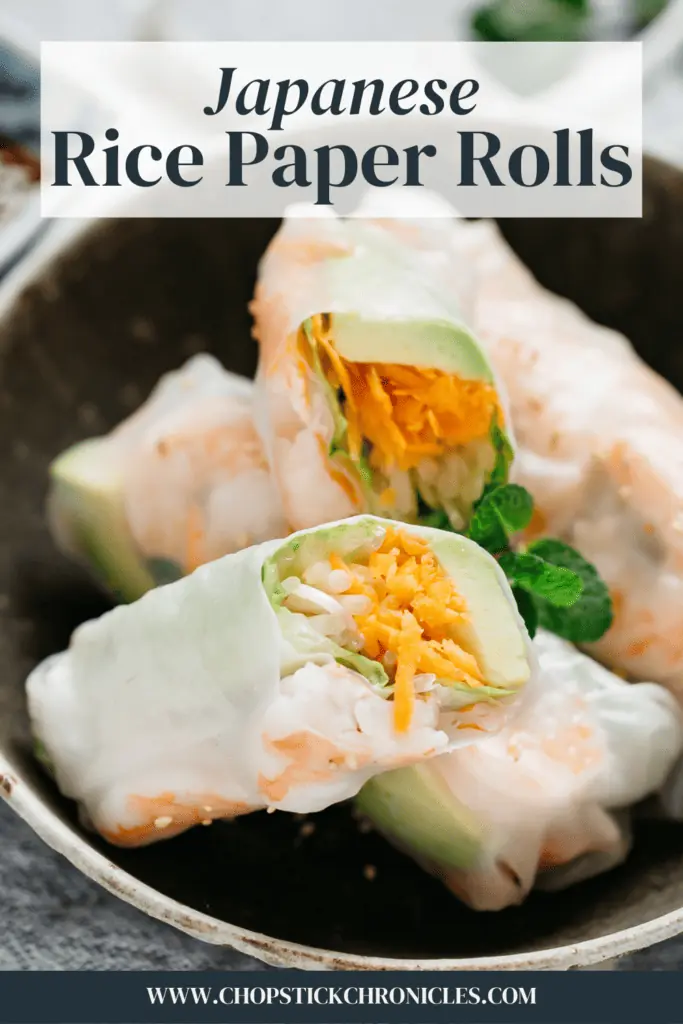
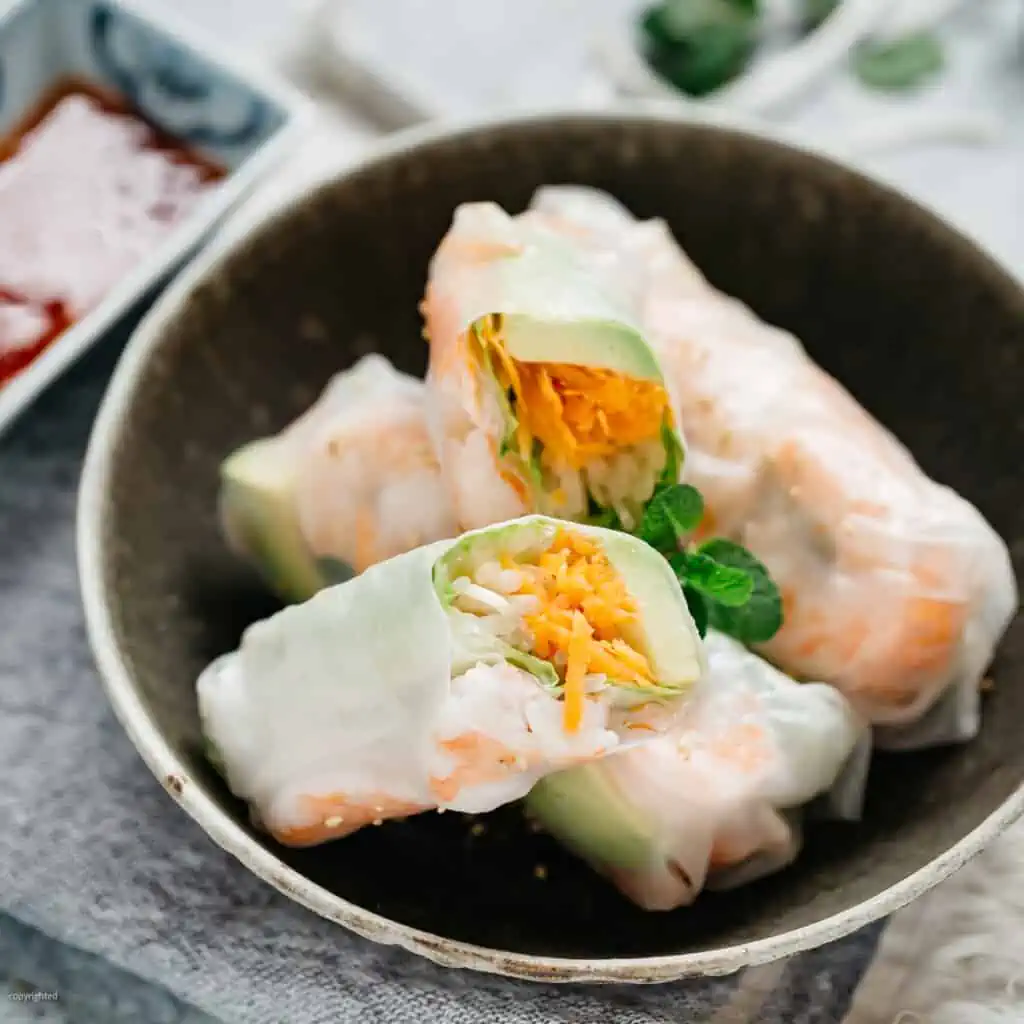
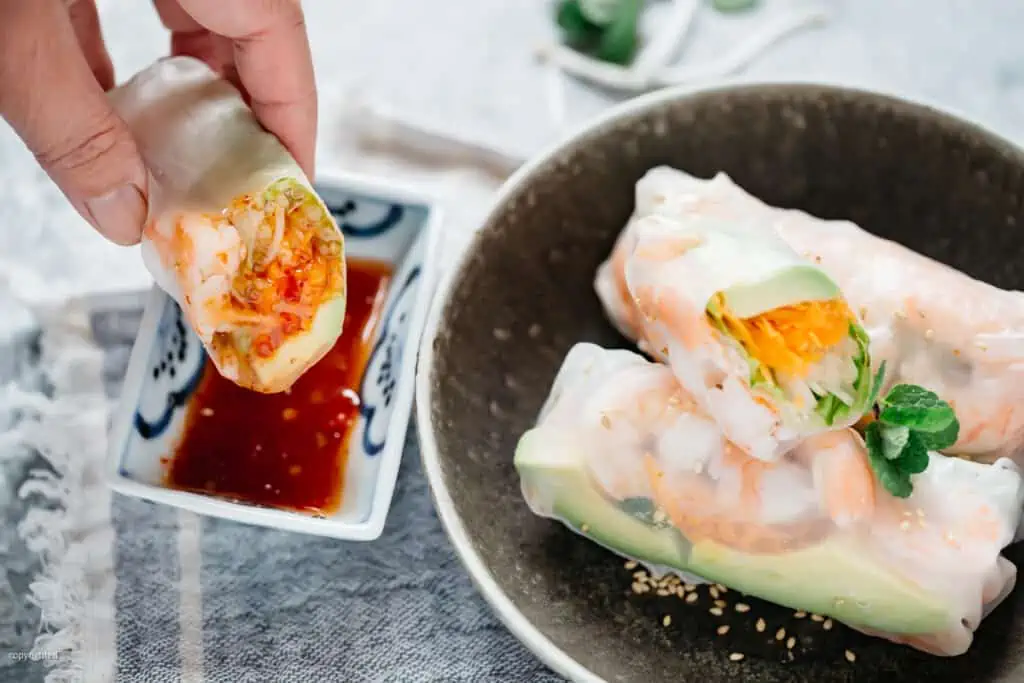
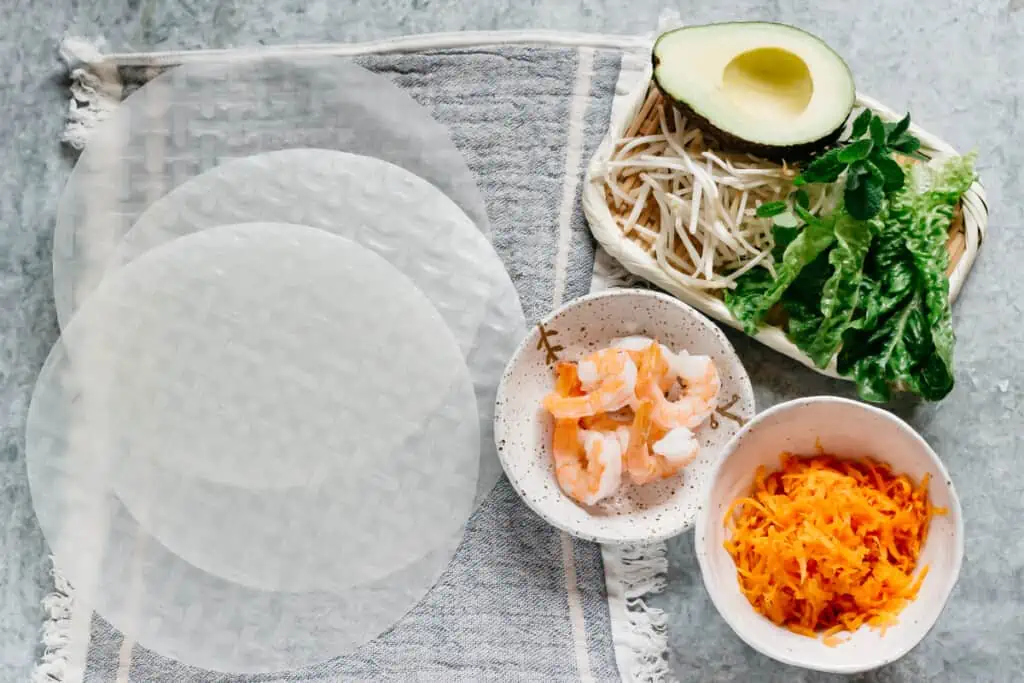
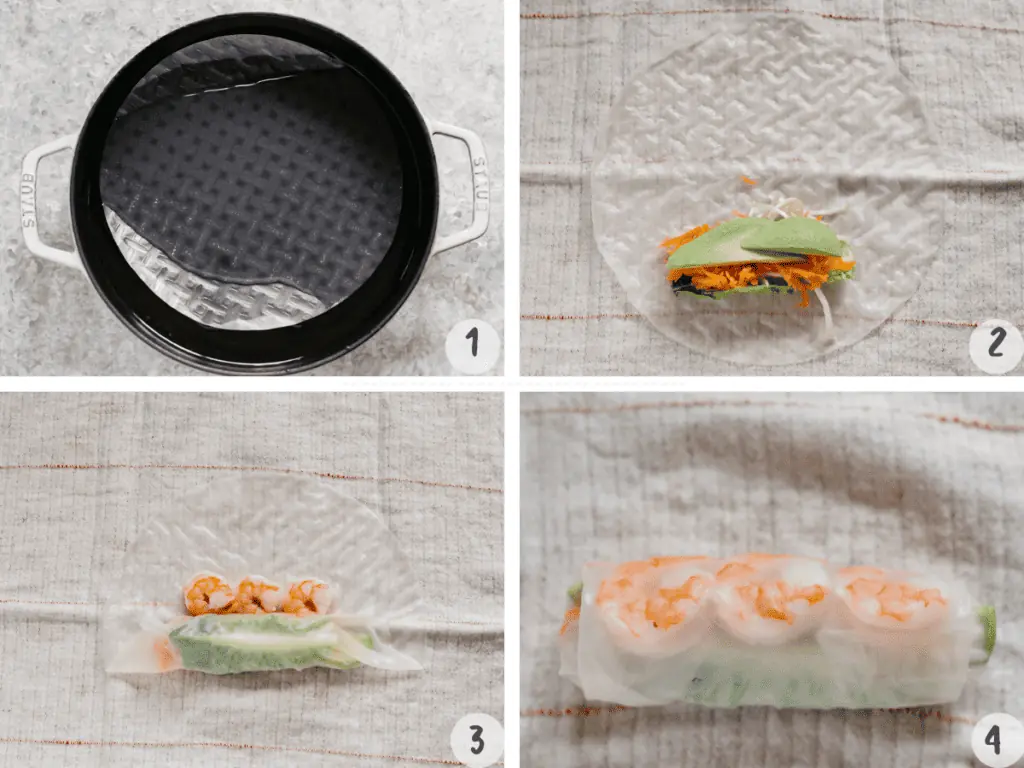
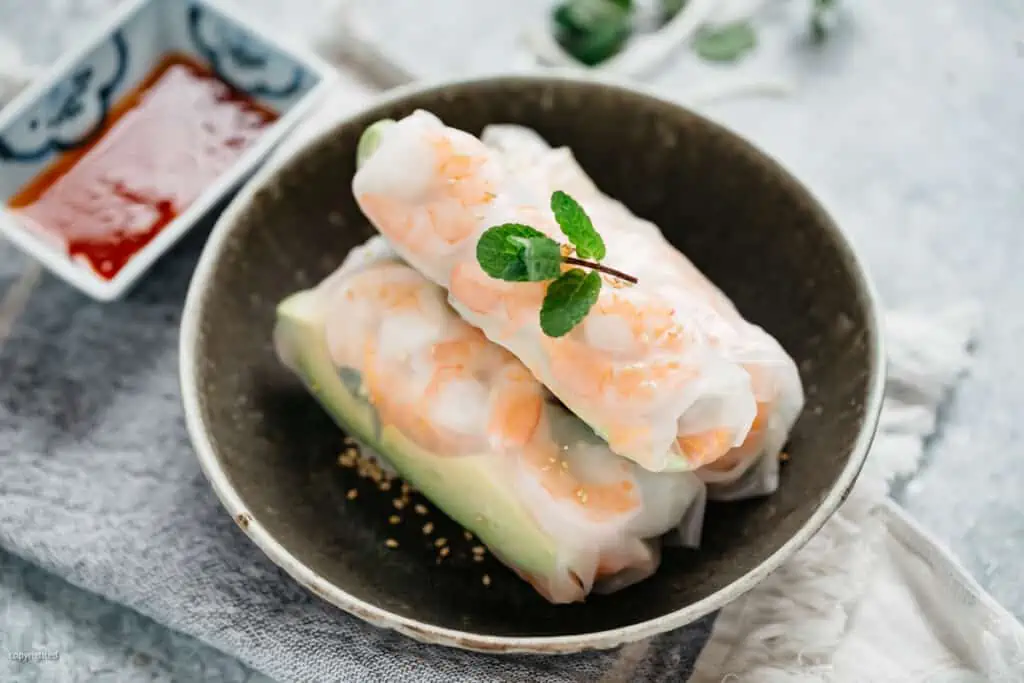

Not sure if I did something wrong. Following the recipe, it’s missing something for me (was quite bland). Adding some soy sauce, it was just alright.
Hi Daniel, Thank you for your feedback.
deliicious!
Thank you!!
Hi Shihoko!
These look so tasty. We are pinning them to make very soon!
I also absolutely love your presentation. What beautiful dishes!
Thanks very much. I love your blog – it is a fantastic resource for gorgeous + delicious Japanese recipes and always such a pleasure to stop by!
Thank you so much for your kind words, Alix 😀
I have never heard of Japanese rice paper rolls before. How are they different from the Vietnamese rolls? Or are they similar with more Japanese ingredients? These look wonderful and delicious 🙂 Just discovered your blog and loving all the recipes!
Hi Gem, Japanese one is not much different from Vietnamese one I guess as they are adopted from Vietnam. I actually don’t know what the Vietnamese one, I made the way I have learnt in Japan so I call it “Japanese” 😀